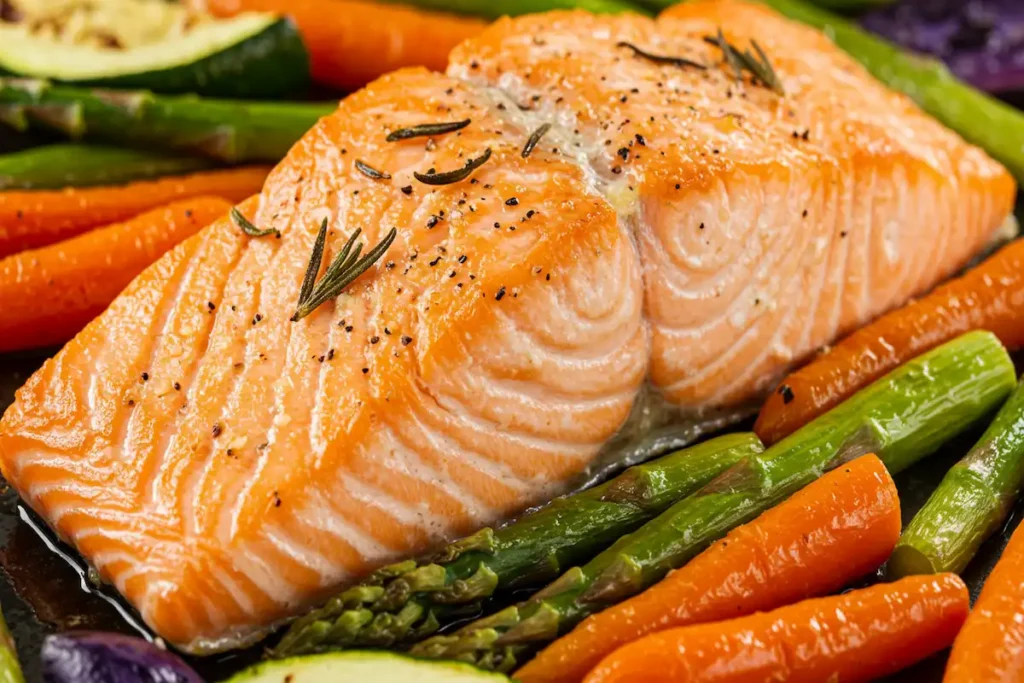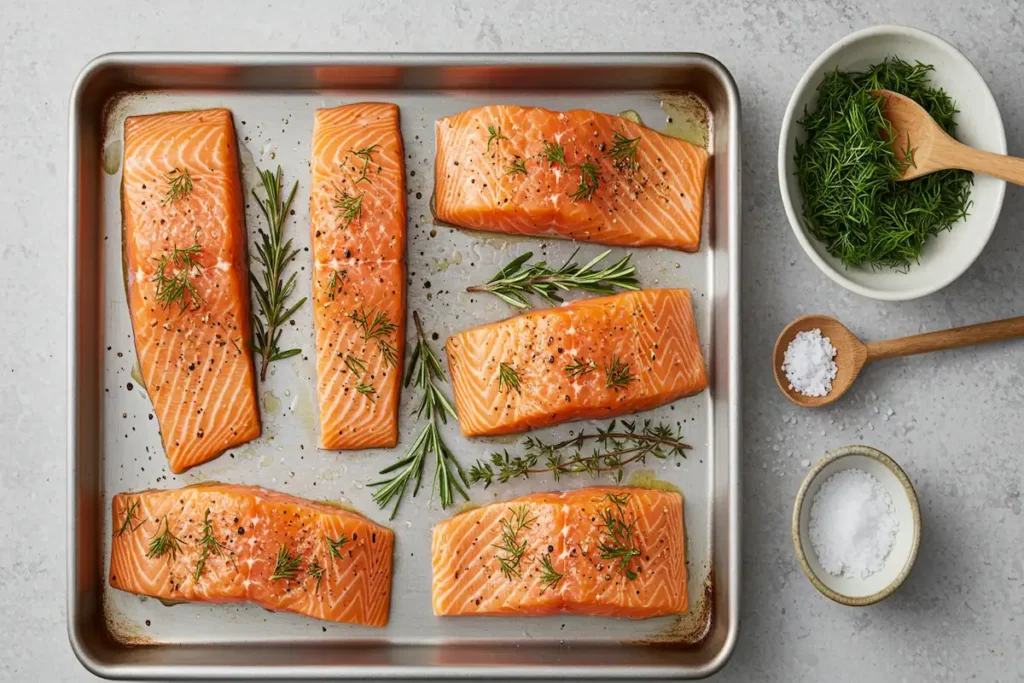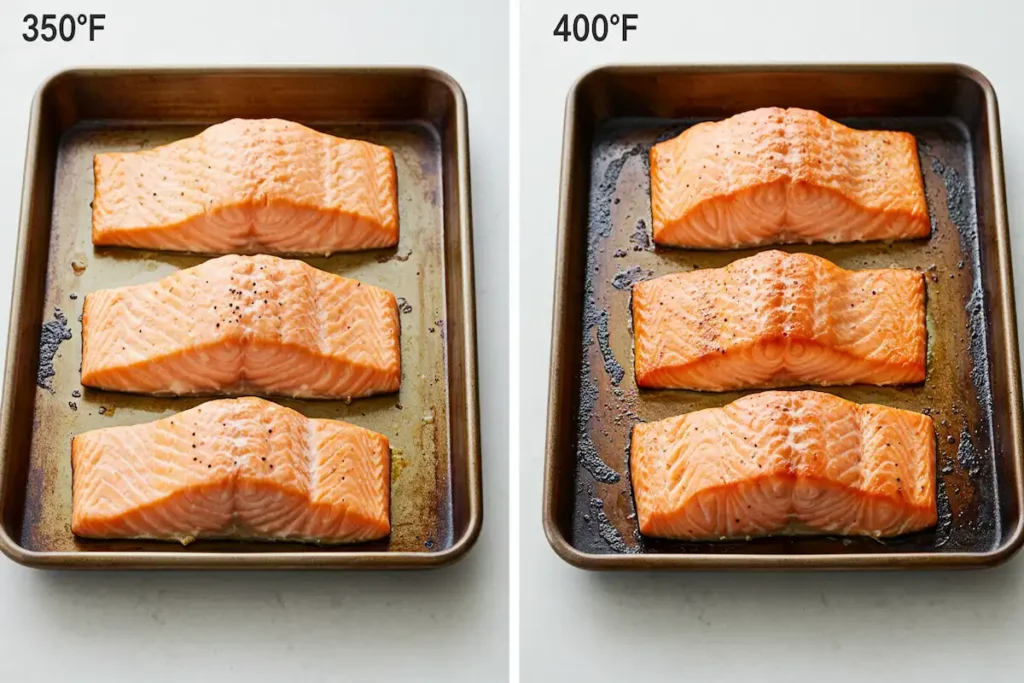Salmon is a versatile and nutrient-packed fish that’s a favorite in kitchens worldwide. Whether you’re a seasoned chef or a beginner, baking salmon is one of the easiest and healthiest ways to prepare it. But here’s the million-dollar question: Is it better to bake salmon at 350 or 400 degrees Fahrenheit?
The answer isn’t as straightforward as you might think. Baking temperature can make or break your salmon, affecting its texture, moisture, and flavor. In this article, we’ll dive deep into the pros and cons of baking salmon at 350°F versus 400°F, provide step-by-step guides, and share expert tips to help you achieve perfectly baked salmon every time.
When it comes to baking salmon, having a reliable recipe can make all the difference. For a delicious and easy-to-follow option, check out this baked salmon recipe that highlights the perfect blend of seasonings and cooking techniques. It’s essential to know how long to cook salmon in the oven to achieve that ideal texture. According to this guide on how long salmon should be cooked in the oven, the cooking time can vary based on the thickness of the fillet and the temperature you choose. By following these tips and recipes, you can ensure that your salmon turns out perfectly every time, whether you opt for baking at 350°F or 400°F.
Why Baking Temperature Matters for Salmon
When it comes to baking salmon, temperature is the secret ingredient that can elevate your dish from good to restaurant-quality. But why does it matter so much? Let’s break it down.
Salmon is a delicate fish with a high fat content, which makes it succulent and flavorful when cooked right. However, it’s also prone to drying out if overcooked. The internal temperature of salmon should reach 145°F for safe consumption, but how you get there depends on the oven temperature you choose.
At 350°F, the salmon cooks more slowly, allowing the heat to penetrate evenly without drying out the fish. On the other hand, 400°F cooks the salmon faster, creating a crispy exterior while keeping the inside moist. But beware higher temperatures can lead to overcooking if you’re not careful.
Texture and Flavor: The Temperature Connection
The texture of your salmon is directly influenced by the baking temperature. At 350°F, the fish remains tender and juicy, making it ideal for those who prefer a softer bite. Meanwhile, 400°F gives you a crispy skin and a slightly firmer texture, perfect for those who love a bit of crunch.
As for flavor, lower temperatures allow the natural oils in the salmon to infuse the fish, enhancing its richness. Higher temperatures, however, can create a caramelized crust that adds a depth of flavor you won’t get at lower temps.
Cooking Time: A Balancing Act
One of the biggest differences between baking salmon at 350°F and 400°F is the cooking time. At 350°F, you’re looking at 12-15 minutes, depending on the thickness of the fillet. At 400°F, the same fillet might take just 8-12 minutes.
If you’re short on time, 400°F is your best bet. But if you’re aiming for even cooking and don’t mind waiting a bit longer, 350°F is the way to go.
Key Takeaways
- 350°F: Even cooking, tender texture, longer time.
- 400°F: Faster cooking, crispy skin, risk of overcooking.
Baking Salmon at 350°F

Now that we’ve established why baking temperature is crucial, let’s dive into the specifics of baking salmon at 350°F. This method is often favored for its ability to produce moist, flaky salmon without the risk of overcooking. But what are the pros and cons? Let’s find out!
Pros and Cons of Baking Salmon at 350°F
Pros: Why Choose 350°F?
- Even Cooking: Baking at 350°F allows the heat to distribute evenly, ensuring that your salmon cooks uniformly. This means you’re less likely to end up with a dry exterior and an undercooked interior.
- Moisture Retention: The slower cooking process helps retain the fish’s natural moisture, resulting in a tender and juicy bite.
- Less Risk of Overcooking: At this temperature, you have a bit more leeway. If you’re distracted or need to run an errand, your salmon is less likely to turn into a dry mess.
Cons: What to Watch Out For
- Longer Cooking Time: If you’re in a hurry, 350°F might not be your best friend. It takes longer to reach that perfect doneness, which can be a downside for busy weeknights.
- Less Crispy Skin: If you love that crispy skin texture, you might find that baking at this temperature doesn’t deliver the crunch you’re after.
Step-by-Step Guide to Baking Salmon at 350°F
Ready to give it a try? Here’s a simple, foolproof method to bake your salmon at 350°F.
Step 1: Preheat the Oven
Start by preheating your oven to 350°F. This ensures that your salmon cooks evenly from the moment it goes in.
Step 2: Prepare the Salmon
While the oven is heating, take your salmon fillet and pat it dry with a paper towel. This helps the seasoning stick better.
Step 3: Season the Salmon
Season your salmon with your favorite spices. A simple mix of salt, pepper, and lemon juice works wonders. You can also add herbs like dill or parsley for an extra flavor boost.
Step 4: Place on a Baking Sheet
Line a baking sheet with parchment paper or lightly grease it. Place the seasoned salmon skin-side down on the sheet.
Step 5: Bake
Pop the salmon in the oven and bake for about 12-15 minutes. The exact time will depend on the thickness of your fillet. A good rule of thumb is to bake for about 4-6 minutes per half-inch of thickness.
Step 6: Check for Doneness
Use a meat thermometer to check the internal temperature. It should read 145°F when done. If you don’t have a thermometer, you can check if the salmon flakes easily with a fork.
Step 7: Let It Rest
Once out of the oven, let your salmon rest for a few minutes. This allows the juices to redistribute, making for a more flavorful bite.
Key Takeaways for Baking at 350°F
Baking salmon at 350°F is a fantastic option if you’re looking for a moist, tender result with less risk of overcooking. Just remember, it takes a bit longer, so plan accordingly!
Baking Salmon at 400°F

If you’re someone who loves crispy skin and quick meals, baking salmon at 400°F might just be your go-to method. This higher temperature delivers a caramelized exterior and a moist interior in less time. But, like any cooking method, it has its pros and cons. Let’s dive in!
Pros and Cons of Baking Salmon at 400°F
Pros: Why Choose 400°F?
- Faster Cooking Time: At 400°F, your salmon will be ready in just 8-12 minutes, making it perfect for busy weeknights or last-minute dinners.
- Crispy Skin: The higher temperature creates a crispy, golden-brown crust that’s irresistible to many salmon lovers.
- Caramelized Edges: The heat helps to caramelize the edges of the salmon, adding a depth of flavor that’s hard to achieve at lower temperatures.
Cons: What to Watch Out For
- Risk of Overcooking: The higher heat means you’ll need to keep a close eye on your salmon. Overcooking can lead to a dry and tough texture.
- Less Even Cooking: The rapid cooking process can sometimes result in unevenly cooked salmon, especially if the fillet is thick.
Step-by-Step Guide to Baking Salmon at 400°F
Ready to try this method? Here’s a simple guide to baking salmon at 400°F for perfect results every time.
Step 1: Preheat the Oven
Start by preheating your oven to 400°F. This ensures that your salmon cooks quickly and evenly.
Step 2: Prepare the Salmon
Pat your salmon fillet dry with a paper towel. This step is crucial for achieving that crispy skin everyone loves.
Step 3: Season the Salmon
Season your salmon generously. A mix of olive oil, salt, pepper, and garlic powder works beautifully. For a zesty twist, add a squeeze of lemon juice or a sprinkle of paprika.
Step 4: Place on a Baking Sheet
Line a baking sheet with parchment paper or lightly grease it. Place the salmon skin-side down on the sheet.
Step 5: Bake
Bake the salmon for 8-12 minutes, depending on the thickness of the fillet. A good rule of thumb is to bake for about 3-4 minutes per half-inch of thickness.
Step 6: Check for Doneness
Use a meat thermometer to check the internal temperature. It should read 145°F when done. If you don’t have a thermometer, look for the salmon to flake easily with a fork.
Step 7: Let It Rest
Once out of the oven, let the salmon rest for a few minutes. This allows the juices to settle, ensuring a moist and flavorful bite.
Key Takeaways for Baking at 400°F
Baking salmon at 400°F is ideal for those who want a quick, crispy result. Just remember to keep an eye on the clock to avoid overcooking!
Comparing 350°F vs. 400°F for Baking Salmon

Now that we’ve explored the ins and outs of baking salmon at both 350°F and 400°F, it’s time to compare the two methods. Each temperature has its unique benefits and drawbacks, and understanding these can help you choose the best approach for your culinary needs.
Which Temperature is Better for Baking Salmon?
When it comes to deciding whether to bake salmon at 350°F or 400°F, it really boils down to your personal preferences and the specific outcome you’re aiming for.
Texture and Moisture
- 350°F: This method is perfect for those who enjoy a tender, moist salmon fillet. The slower cooking process allows the fish to retain its natural oils, resulting in a rich flavor and a soft texture.
- 400°F: If you’re after a crispy skin and a firmer texture, then baking at 400°F is the way to go. The higher heat creates a delightful contrast between the crispy exterior and the moist interior.
Cooking Time
- 350°F: Expect a longer cooking time of about 12-15 minutes, which can be a downside if you’re in a hurry. However, this method is more forgiving if you need to step away for a moment.
- 400°F: With a cooking time of just 8-12 minutes, this method is ideal for quick meals. Just be sure to keep an eye on the salmon to prevent overcooking.
Flavor Development
- 350°F: The lower temperature allows for a more gradual flavor development, enhancing the natural taste of the salmon. It’s great for those who prefer a more subtle flavor profile.
- 400°F: The higher temperature promotes caramelization, adding a depth of flavor that many find irresistible. If you enjoy a bit of crunch and a more robust taste, this method is for you.
Expert Tips for Perfectly Baked Salmon
Regardless of the temperature you choose, here are some expert tips to ensure your salmon turns out perfectly every time:
- Use a Meat Thermometer: This is your best friend in the kitchen. It takes the guesswork out of cooking and ensures your salmon reaches the ideal internal temperature of 145°F.
- Let Salmon Rest: After baking, let your salmon rest for a few minutes. This allows the juices to redistribute, resulting in a more flavorful bite.
- Experiment with Seasonings: Don’t be afraid to get creative! Try different marinades, herbs, and spices to find your perfect flavor combination.
- Avoid Overcrowding: If you’re baking multiple fillets, make sure they’re spaced out on the baking sheet. This allows for even cooking and helps achieve that desired crispy skin.
Key Takeaways
- Choose 350°F for a moist, tender result with a longer cooking time.
- Opt for 400°F if you want a crispy, quick meal with a caramelized flavor.
- Regardless of your choice, follow expert tips for the best results!
FAQs Section About Baking Salmon
As we wrap up our exploration of baking salmon at 350°F and 400°F, it’s time to address some frequently asked questions. These queries often pop up for home cooks looking to perfect their salmon game. Let’s dive in!
How Long Should I Bake Salmon at 350°F?
When baking salmon at 350°F, the general rule of thumb is to cook it for about 12-15 minutes. The exact time will depend on the thickness of your fillet. A good guideline is to bake for approximately 4-6 minutes per half-inch of thickness. Always check for doneness using a meat thermometer; the internal temperature should reach 145°F.
How Long Should I Bake Salmon at 400°F?
If you opt for 400°F, your salmon will cook much faster typically around 8-12 minutes. Again, the cooking time will vary based on the thickness of the fillet. For best results, use the same guideline of 3-4 minutes per half-inch of thickness. Keep an eye on it to avoid overcooking!
What is the Best Temperature to Bake Salmon?
The best temperature to bake salmon really depends on your personal preference. If you enjoy a moist, tender texture, go for 350°F. If you prefer a crispy skin and a quicker cooking time, then 400°F is your best bet. Both methods can yield delicious results, so it’s worth experimenting to find your favorite!
Can I Bake Salmon from Frozen?
Yes, you can bake salmon from frozen! However, you’ll need to increase the cooking time by about 5-10 minutes. It’s best to bake at 350°F for even cooking, as the lower temperature helps ensure that the fish cooks through without drying out. Just make sure to check the internal temperature to ensure it reaches 145°F.
How Do I Know When Salmon is Done?
The most reliable way to check if your salmon is done is to use a meat thermometer. The internal temperature should read 145°F. If you don’t have a thermometer, you can also check for doneness by gently flaking the salmon with a fork. If it flakes easily and is opaque throughout, it’s ready to eat!
Can I Use Aluminum Foil When Baking Salmon?
Absolutely! Using aluminum foil can help retain moisture and prevent the salmon from drying out. You can wrap the salmon in foil or place it on a baking sheet lined with foil for easy cleanup. Just remember to leave some space for air circulation if you’re wrapping it.
What Are Some Good Side Dishes for Baked Salmon?
Baked salmon pairs wonderfully with a variety of side dishes. Consider serving it with roasted vegetables, quinoa, or a fresh salad. For a comforting option, mashed potatoes or rice pilaf also make great companions.
Key Takeaways
- Baking salmon at 350°F takes longer but yields a moist result, while 400°F cooks it faster with a crispy finish.
- Always check for doneness using a meat thermometer to ensure food safety.
- Feel free to experiment with cooking from frozen and using aluminum foil for added moisture.
Summary and Final Thoughts on Baking Salmon
As we conclude our deep dive into the question, “Is it better to bake salmon at 350 or 400?”, it’s clear that both temperatures have their unique advantages and can yield delicious results. Let’s recap the key points to help you make the best choice for your next salmon dish.
Baking Salmon at 350°F
- Pros: This method is ideal for achieving a moist, tender salmon fillet. The slower cooking process allows for even heat distribution, reducing the risk of overcooking.
- Cons: The downside is the longer cooking time, which can be a drawback if you’re in a hurry. Additionally, you may not achieve that crispy skin that many people love.
- Cooking Time: Expect to bake for about 12-15 minutes, depending on the thickness of the fillet.
Baking Salmon at 400°F
- Pros: If you’re looking for a quick meal with a crispy exterior, baking at 400°F is the way to go. This method caramelizes the edges, adding a delightful flavor.
- Cons: The main concern is the risk of overcooking, as the higher temperature requires more attention. Uneven cooking can also occur if the fillet is thick.
- Cooking Time: You’ll typically bake for 8-12 minutes, making it a great option for busy weeknights.
Choosing the Right Method for You
Ultimately, the choice between baking salmon at 350°F or 400°F comes down to your personal preferences and the specific outcome you desire. If you value moisture and tenderness, go for the lower temperature. If you’re after speed and crispiness, the higher temperature is your best bet.
Expert Tips for Success
- Always use a meat thermometer to check for doneness, aiming for an internal temperature of 145°F.
- Let your salmon rest for a few minutes after baking to enhance flavor and juiciness.
- Don’t hesitate to experiment with different seasonings and marinades to find your perfect flavor profile.
Final Thoughts
Baking salmon is a simple yet rewarding cooking method that can fit into any meal plan. Whether you choose to bake at 350°F or 400°F, you’re sure to enjoy a delicious and nutritious dish. So, roll up your sleeves, grab your favorite salmon fillet, and get cooking!
For more tips on Selecting and Serving Fresh and Frozen Seafood Safely, check out this resource from the USDA.
